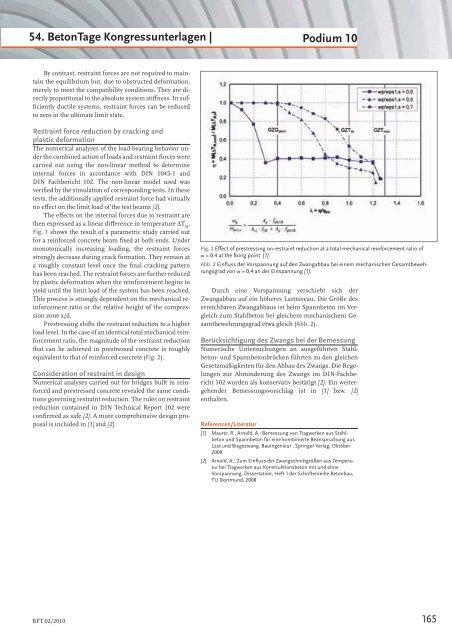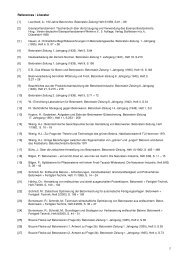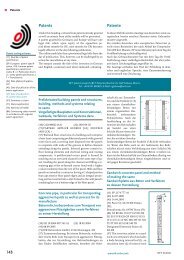Concrete Plant + Precast Technology Betonwerk ... - BFT International
Concrete Plant + Precast Technology Betonwerk ... - BFT International
Concrete Plant + Precast Technology Betonwerk ... - BFT International
Sie wollen auch ein ePaper? Erhöhen Sie die Reichweite Ihrer Titel.
YUMPU macht aus Druck-PDFs automatisch weboptimierte ePaper, die Google liebt.
54. BetonTage Kongressunterlagen |<br />
By contrast, restraint forces are not required to maintain<br />
the equilibrium but, due to obstructed deformation,<br />
merely to meet the compatibility conditions. They are directly<br />
proportional to the absolute system stiff ness. In suffi<br />
ciently ductile systems, restraint forces can be reduced<br />
to zero in the ultimate limit state.<br />
Restraint force reduction by cracking and<br />
plastic deformation<br />
The numerical analyses of the load-bearing behavior under<br />
the combined action of loads and restraint forces were<br />
carried out using the non-linear method to determine<br />
internal forces in accordance with DIN 1045-1 and<br />
DIN Fachbericht 102. The non-linear model used was<br />
verifi ed by the simulation of corresponding tests. In these<br />
tests, the additionally applied restraint force had virtually<br />
no eff ect on the limit load of the test beams [2].<br />
The eff ects on the internal forces due to restraint are<br />
then expressed as a linear diff erence in temperature ∆T M .<br />
Fig. 1 shows the result of a parametric study carried out<br />
for a reinforced concrete beam fi xed at both ends. Under<br />
monotonically increasing loading, the restraint forces<br />
strongly decrease during crack formation. They remain at<br />
a roughly constant level once the fi nal cracking pattern<br />
has been reached. The restraint forces are further reduced<br />
by plastic deformation when the reinforcement begins to<br />
yield until the limit load of the system has been reached.<br />
This process is strongly dependent on the mechanical reinforcement<br />
ratio or the relative height of the compression<br />
zone x/d.<br />
Prestressing shifts the restraint reduction to a higher<br />
load level. In the case of an identical total mechanical reinforcement<br />
ratio, the magnitude of the restraint reduction<br />
that can be achieved in prestressed concrete is roughly<br />
equivalent to that of reinforced concrete (Fig. 2).<br />
Consideration of restraint in design<br />
Numerical analyses carried out for bridges built in reinforced<br />
and prestressed concrete revealed the same conditions<br />
governing restraint reduction. The rules on restraint<br />
reduction contained in DIN Technical Report 102 were<br />
confi rmed as safe [2]. A more comprehensive design proposal<br />
is included in [1] and [2].<br />
<strong>BFT</strong> 02/2010<br />
Podium 10<br />
Fig. 2 Eff ect of prestressing on restraint reduction at a total mechanical reinforcement ratio of<br />
v = 0.4 at the fi xing point [1].<br />
Abb. 2 Einfl uss der Vorspannung auf den Zwangabbau bei einem mechanischen Gesamtbewehrungsgrad<br />
von v = 0,4 an der Einspannung [1].<br />
Durch eine Vorspannung verschiebt sich der<br />
Zwangabbau auf ein höheres Lastniveau. Die Größe des<br />
erreichbaren Zwangabbaus ist beim Spannbeton im Vergleich<br />
zum Stahlbeton bei gleichem mechanischem Gesamtbewehrungsgrad<br />
etwa gleich (Abb. 2).<br />
Berücksichtigung des Zwangs bei der Bemessung<br />
Numerische Untersuchungen an ausgeführten Stahlbeton-<br />
und Spannbetonbrücken führten zu den gleichen<br />
Gesetzmäßigkeiten für den Abbau des Zwangs. Die Regelungen<br />
zur Abminderung des Zwangs im DIN-Fachbericht<br />
102 wurden als konservativ bestätigt [2]. Ein weitergehender<br />
Bemessungsvorschlag ist in [1] bzw. [2]<br />
enthalten.<br />
References/Literatur<br />
[1] Maurer, R., Arnold, A.: Bemessung von Tragwerken aus Stahlbeton<br />
und Spannbeton für eine kombinierte Beanspruchung aus<br />
Last und Biegezwang. Bauingenieur , Springer Verlag, Oktober<br />
2009<br />
[2] Arnold, A.: Zum Einfl uss der Zwangschnittgrößen aus Temperatur<br />
bei Tragwerken aus Konstruktionsbeton mit und ohne<br />
Vorspannung. Dissertation, Heft 1 der Schriftenreihe Betonbau,<br />
TU Dortmund, 2008<br />
165












